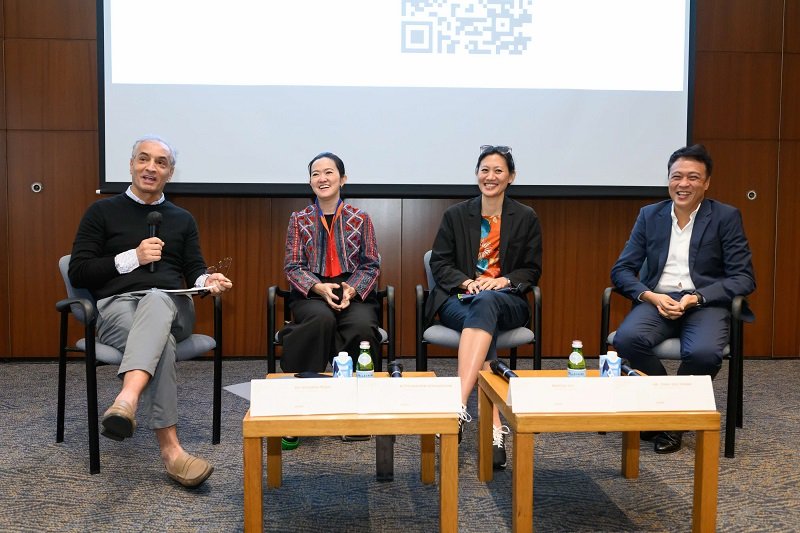International and local jurors of the 2023 President*s Design Award (P*DA) share what it means to create well-designed spaces for people at the P*DA Jurors Forum on 17 February 2023. Read on for the insights.
1. Embrace nature
“Instead of having nature adapt to us, we need to learn to adapt ourselves to nature.” As we find solutions to address the effects of climate change, Thai landscape architect, Kotchakorn Voraakhom, reminds us that we need to first learn how to embrace our natural environments, treating our infrastructure like our own bodies that have a life of their own.
Whether it is revitalising Bangkok’s downtown canal or creating Asia’s largest rooftop at Thammast University with multiple functions, for play, to grow food and generate solar energy, Kotchakorn’s design solutions are examples of how we can design and adapt our infrastructures to live well with nature.

The Chong Nonsi Canal Park in Bangkok, a revitalised canal in the business district. Image credit: Ded Filmlandscape
2. Involve the community
Beyond living well with nature, design solutions can impact and benefit larger communities. “As designers, we need to break away from our silos and engage wider communities as much as possible.” In one of his projects, Soori Bali, a boutique hotel villa and residence, Singapore architect, Chan Soo Khian, saw how integrating the hotel within the surrounding environments and involving the wider community had made a difference in people’s lives. The development provided access to the nearby temples and irrigation pathways for farmers. Local materials were used, and local craftsmen were employed. 85 per cent of the staff at the hotel were from the local villages. A nursery was also set up to support local fauna and a dance school served the local community.

Soori Bali, by SCDA. Image credit: SCDA
3. Start small
If good design can change one’s environment for the better, how can we inspire further action? Architect Marisa Yiu believes that sparking change can start from very small efforts.
“What is the future of micro parks in Hong Kong?” Beginning with a simple proposition, Marisa, co-founder of the non-profit group, Design Trust, that has been driving design projects in Hong Kong, led experimental ideas to redesign four park spaces from 2018 under its Futures Studio, where young designers worked closely with the community.
The delightful parks and public spaces created re-energised communities and brought many generations of people together. Their benefits and impact inspired another 170 park spaces to be identified for further improvement.

Yi Pei Square Playground, one of the park spaces that was transformed, led by Design Trust. Image credit: Design Trust
4. Focus on design process
In designing prototypes for the park spaces, beyond creating impactful designs, Marisa found that it was also equally important to focus on the design process and identify who else could be engaged besides designers and the community.
“We should respect and tap on everyone’s different expertise.” For example, when designing a playground, the design process could include psychologists, non-profit champions, and playground design experts.
5. Design with impact
Seeing the impact that the transformed park spaces had on the community, Marisa reminds us that creating well-designed public spaces will become increasingly important, especially in high-density cities.
She believes that “access to public space is a human right.” The way our public spaces are designed and placed within our neighbourhoods can have a major impact on our mental health and well-being. She hopes the efforts to redesign park spaces in Hong Kong can further challenge policy makers, designers and communities to continue to work together to design and create open, diverse and humanising spaces throughout the city.
6. Nurture the next generation
Ultimately, creating well-designed spaces requires building up more design-conscious communities, who can appreciate good designs and can meaningfully participate in design efforts.
In finding creative solutions to address climate change, Kotchakorn emphasises the need to teach our younger generation to learn to live with nature. “The sustainability of a city is also about nurturing and building up design champions.” Since it was formed in 2014, Marisa shared that Design Trust has brought together over 500 young designers with experienced mentors to lead and contribute to design projects.

From left to right, Dr Hossein Rezai, Jury Chair of the P*DA Design Panel and the three P*DA Jury Members at the P*DA Jurors Forum’s first segment on 17 February 2023, Kotchakorn Voraakhom, Marisa Yiu and Chan Soo Khian.
The President*s Design Award is Singapore’s highest honour for designers and designs across all disciplines. The 2023 award will be in July, where the Design of the Year and Designer of the Year from architecture and other design disciplines will be conferred. For more information about the award, go to https://pda.designsingapore.org/presidents-design-award/
Source: https://www.ura.gov.sg/Corporate/Resources/Ideas-and-Trends/design-better-worlds


